This site is part of various affiliate programs. Links may give us a small compensation for any purchases you make, at no additional cost to you. Please read the disclaimer policy for full details.
Gaomon are one of the newer manufacturers of drawing tablets, that first released a tablet globally in 2016, with their tablets aimed at those who want the premium features of Wacom graphics tablets, but don’t have the budget to afford one.
In this article, I compare Gaomon vs Wacom across the smaller, screen-less pen tablets, medium drawing tablets, and larger-sized graphics tablets, showing you the differences and similarities between the tablets in each category.
Gaomon S620 vs Wacom Intuos
If you are looking for a Gaomon osu pad, then the S620 will have come up on your radar, but this is also a really good, budget pen pad in general. It doesn’t have the features that make the Wacom Intuos the better tablet for me, but it is still an excellent choice for those starting out with drawing tablets.
There is also a cheaper Wacom tablet available, the Wacom One (or One by Wacom). Compare the Intuos and Wacom One in this article.
Recommended
High Build Quality & Value for Money
- Highest build quality and performance of any cheap tablet, with nearly all the features of much more expensive models
- Compact and easily portable, but can take knocks and bumps
- Bluetooth connection, so no cables to deal with
- Excellent stylus with highest accuracy outside of pro tablets
- Button position means you must reach over the tablet to use them
- More expensive than the Gaomon tablet
Gaomon OSU Tablet
- Large 6.5 x 4 inch active area
- 4 customizable buttons
- Low price makes it very attractive for budget users
- Same pen pressure sensitivity, report rate & resolution of the Wacom Intuos
- The cheapest small drawing tablet
- Not compatible with Hawku’s drivers for OSU
- Noticeably lower build quality than the Intuos with lower pen accuracy in practice
Differences Between the Wacom Intuos vs Gaomon S620
| Differences between the Gaomon S620 and Wacom Intuos | 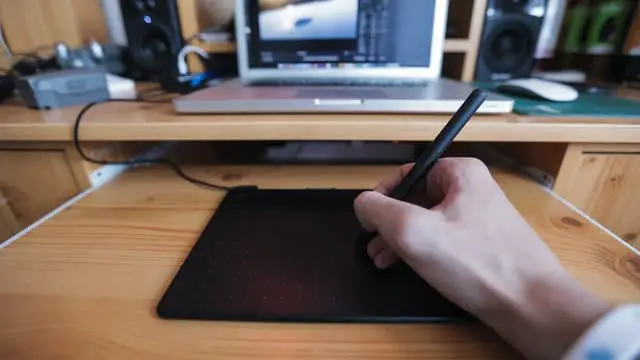 |
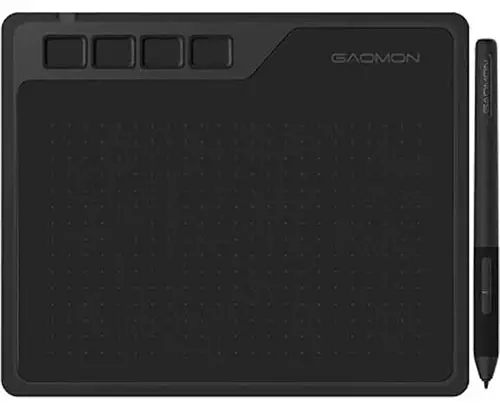 |
|---|---|---|
| Active Area |
|
|
| OSU Drivers |
|
|
| Replacement Nibs |
|
|
| Included Software |
|
|
| Wireless Connection |
|
|
| Cost |
|
|
The detailed differences between the pen tablets:
- Active Area Size
- The Wacom Intuos has a 6.0 x 3.7 inch active area, while the Gaomon S620 has a 6.5 x 4.0 inch active area. You will be unlikely to notice the difference in practice, but if the Intuos active area was too small for you, then the Medium model of Intuos has an active area of 8.5 x 5.3 inches.
- OSU Drivers
- The Intuos can use OSU drivers, while the S620 is not configured to use them. These reduce pen latency and generally speed up your workflow.
- Included Nibs
- The Intuos only has four nibs included, compared to the S620’s eight, but the Intuos nibs are of higher quality and are likely to last longer, so I wouldn’t necessarily consider this a win for the S620.
- Included Software
- The Intuos has 90-day trial versions of Corel software, plus a 2-year license to Clip Studio Paint Pro, which is incredibly useful for artists just starting out.
- Wireless Connection
- The Intuos uses Bluetooth or a cabled connection, making it much easier to use with a laptop or desktop where your USB ports are inconveniently placed. The S620 must use a USB connection.
- Cost
- The S620 is around one third of the price of the Intuos.
Similarities between the drawing tablets:
- Programmable Buttons
- Both tablets have four programmable buttons, plus two on the pens.
- Tablet Size
- The Intuos is 7.87 x 6.3 x 0.35 inches and weighs 8.8 ounces, while the S620 is 8.3 x 6.85 x 0.31 inches and the same weight.
Gaomon PD1161 vs Wacom One
The PD1161 and the One are the smallest graphics tablets with screens available from Gaomon and Wacom respectively. These are ideally suited to beginners to drawing, who want a screen in their tablet.
Recommended
Excellent value for money
- 11.6 inch Full HD screen with 100% sRGB colors
- 8 customizable buttons
- One of the cheapest drawing tablets with screens
- Includes replaceable anti-glare film
- The AP50 pen can exhibit lag at times due to driver issues
- Requires 12v power, so is difficult to power with USB alone and needs a wall socket
Good First Drawing Tablet with Screen
- Real-feel Pen, feels like using a real pen
- 13.3″ Full HD Display
- Integrated Stand to raise the display to 19 degrees
- Lovely matte drawing surface shows Wacom’s high quality build
- No buttons on the tablet
- Fairly expensive
Differences Between the Wacom One vs Gaomon PD1161
| Differences between the Wacom One and Gaomon PD1161 | 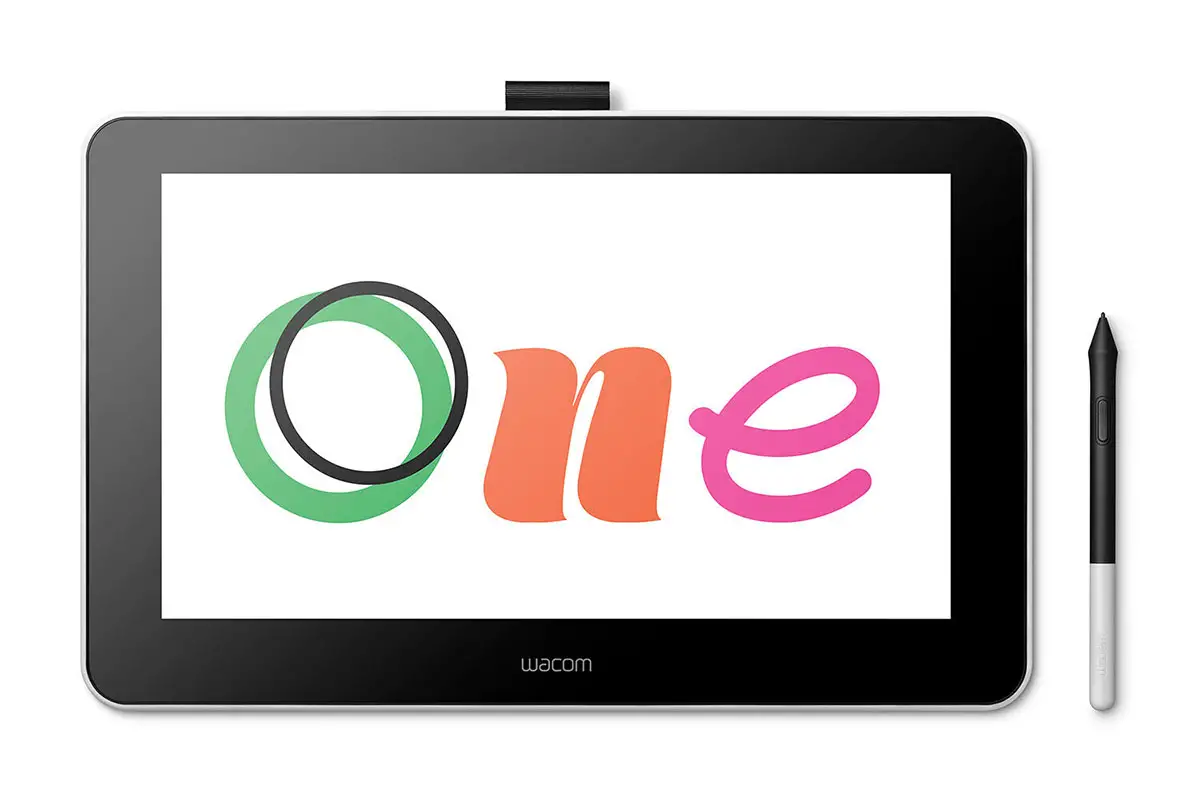 |
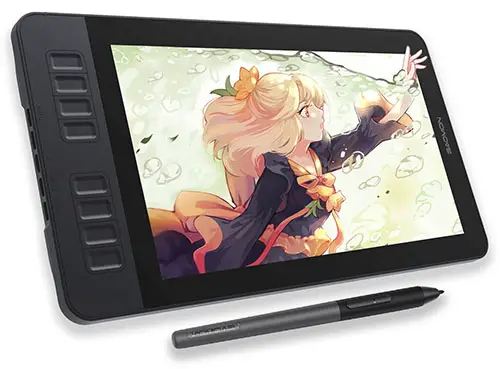 |
|---|---|---|
| Buttons |
|
|
| Screen Size |
|
|
| Integrated Stand |
|
|
| Drivers |
|
|
| Included Software |
|
|
| Cost |
|
|
What are the differences in detail?
- Programmable Buttons
- The One has no programmable buttons on the tablet. while the PD1161 has eight, which are a massive bonus for assigning keyboard shortcuts and speeding up your workflows. Both have two buttons on their pens.
- Screen Size
- The One has the larger screen, but this also makes it less portable. If you are going to use your tablet largely at home, then the benefits of the larger screen might outweigh the size and weight cost.
- Integrated Stand
- The Wacom One has an integrated stand that raises the tablet to 19 degrees. This is very useful for drawing. The Gaomon PD1161 needs a stand that must be bought separately, and feels a lot cheaper and less premium.
- Drivers
- Wacom’s drivers and software are far superior than Gaomon’s, which can add pen lag and other negatives to the experience. If you want a hassle-free tablet, then that points to Wacom.
- Included Software
- Wacom include several months long trial versions of various Adobe and Clip Studio products, which are very helpful for both beginners and those who have used tablets before, while Gaomon have no included software.
- Cost
- Being larger and better built, the Wacom One is about twice the price of the Gaomon PD1161, which I don’t feel is quite value for money, but you do get an excellent, hassle-free drawing tablet in Wacom One.
And what is the same?
- On-Paper Pen Specifications
- Although the various pen specifications like tilt angle and report rate are the same between the tablets, the superior drivers and drawing surface of the Wacom One give this a better pen in practice.
Gaomon PD1560 vs Wacom Cintiq
Two of the largest drawing tablets from Wacom and Gaomon are the Cintiq and PD1560 respectively. These are very well-suited to those who will be using their tablets regularly. The size and expense of these means that they are aimed more at professional or semi-professional users, art students and like.
My Top Pick
The Best Drawing Tablet with Screen
- 15.6″ Full HD Display with the least parallax of any model
- 96% sRGB Coverage for very high color accuracy
- Excellent screen design with paper-like texture and with premium anti-glare film
- Fantastic Pen Accuracy and +/- 60 degrees tilt recognition in the pen
- Wacom Pro Pen 2 shows no lag and beats every other stylus available
- Expensive
- No buttons on the tablet
Cheap & with plenty of programmable buttons
- 15.6-inch full HD screen, same as the Wacom
- 10 programmable buttons
- Significantly lower price makes up for the loss of build quality and lower pen accuracy
- 100% of sRGB colors, but lacking subtlety in greens
- Greater parallax than the Wacom
- Worse drivers and overall feels cheaper, with more pen lag
Differences Between the Wacom Cintiq vs Gaomon PD1560
| Differences between the Wacom Cintiq 16 and Gaomon PD1560 | 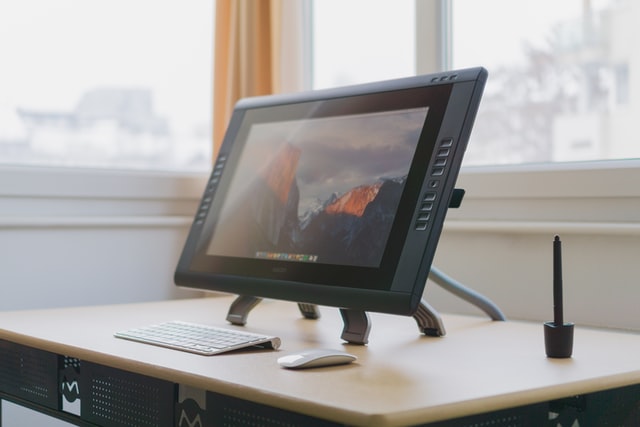 |
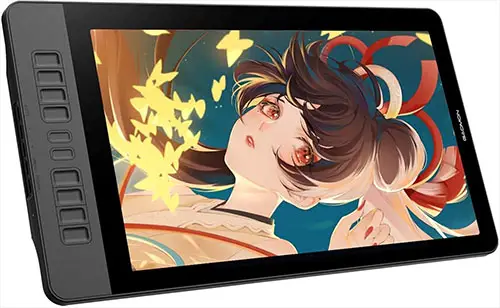 |
|---|---|---|
| Buttons |
|
|
| Display Design |
|
|
| Drawing Surface |
|
|
| Passive vs Active Pen |
|
|
| Software & Drivers |
|
|
| Weight |
|
|
| Cost |
|
|
What are the differences in detail?
- Programmable Buttons
- The Wacom Cintiq does not have any programmable buttons on the tablet, which is a significant disadvantage for those who want to assign keyboard shortcuts to speed up their workflows. The Gaomon PD1560 has ten programmable buttons, which come in very useful in practice.
- Display Design
- The Cintiq has a cleverly designed screen that minimizes parallax and makes the screen seem fully laminated, even if it technically isn’t. This makes accuracy much higher than the non-fully laminated screen of the PD1560.
- Drawing Surface
- Wacom make premium matte feel drawing surfaces that are the closest to paper you can get from a drawing tablet. Gaomon offer a more glossy, smoother drawing surface which doesn’t have that premium feel.
- Passive vs Active Pen
- The PD1560 has an active pen that must be charged via USB, while the Cintiq’s pen is battery free and does not require charging.
- Software & Drivers
- As always, Wacom’s drivers and included software are first-rate, with the pen showing minimal lag and having plenty of customization options, including an on-screen radial menu. Gaomon’s drivers are not as well-developed, and can cause some pen lag in use.
- Weight
- The Gaomon is lighter than the Cintiq, making it more portable, although in practice you would rarely take tablets of this size out of your house.
- Cost
- The Cintiq is a premium product with a price tag to match, while the Gaomon is ideally suited to those aspiring professionals who want a solid drawing tablet at a reasonable price.
What is the same between the graphics tablets?
- Color Gamut
- Both tablets have about the same percentage of sRGB colors, but the colors look much better on the Cintiq in practice.
- On-Paper Specifications
- Most listed specs are identical or pretty close between the two tablets, although in practice the Cintiq shows a higher build quality, and offers greater pen accuracy without lag.
More: See the overall best drawing tablet.
But Which Differences Actually Matter?
Although I have covered all of the differences between Wacom vs Gaomon drawing tablets above, it can be difficult to know which are the really key differences that you should look out for. Those that most people care about are below, but of course might not be appropriate for you, depending on how you intend to use your tablet.
1. Customizable Buttons
Programmable buttons can be very helpful to assign keyboard shortcuts and speed up your workflow. Gaomon software only tends to allow one set of shortcuts to be assigned at once, while Wacom software lets you set a button to do different things depending on the program you are using on your computer.
Some models of drawing tablet have physical buttons, like all of the Gaomon tablets and the Wacom tablets without screens, while some tablets, like the Cintiq’s and other Wacom screened tablets, have on-screen radial menus to simulate physical buttons.
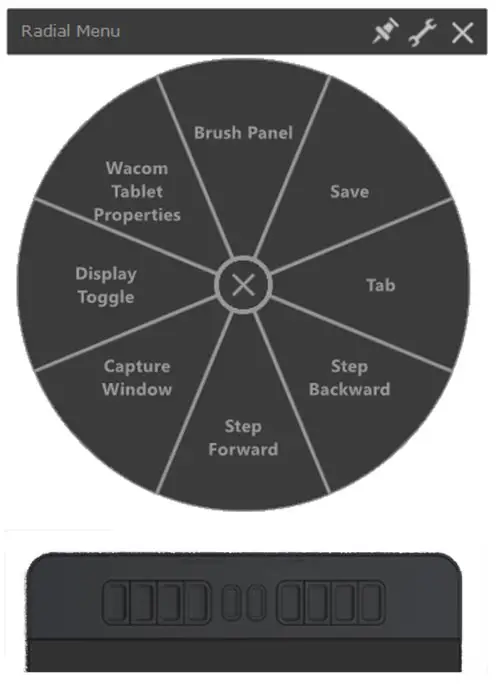
2. Drawing Performance
The Pro Pen 2 from Wacom is widely considered the market leader, and the best stylus for drawing tablets available. This is found in the Wacom Cintiq line, but is not in the Wacom One or the Intuos. These use less powerful pens, although they are still superior to those offered by Gaomon.

3. Screen Presence & Parallax
Whether you want a screen with your drawing tablet or not is one of the most important decisions you need to make.
Those who typically use a tablet for line drawings and animation usually prefer a screen, as this means that you can see the line appear directly under the nib. This is also useful for beginners to drawing tablets.
But tablets without screens are popular among photo editors and professional illustrators, as they offer a superior drawing surface, and also their lower cost and weight makes them much more portable.
If you do decide on a tablet with screen, then you need to be aware of parallax. This is caused by thicker screens increasing the distance between the pen nib and the display, and means that lines can appear to not be directly under the pen.
Wacom tablets exhibit the least parallax in general.
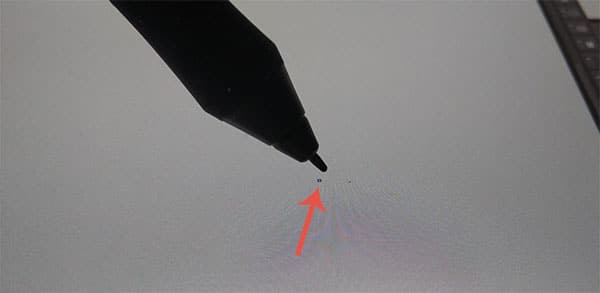
4. Portability
If you are going to be using your tablet entirely at home from your desk, then size, weight and power are not going to be an issue. But if you will be travelling or using your graphics tablet away from home, then you should consider portability, particularly if you are looking at a tablet with screen.
Tablets with screens tend to be both pretty big and heavy, and often require a dedicated power supply in order to work. This makes them less suitable for use with a laptop, unless you are going for one of the smallest screen sizes.
Is Gaomon a Good Brand?
Gaomon are one of the newest brands of drawing tablets, and although not as high quality as the market leaders Wacom, their tablets still work very well and are excellent value for money.
If you’re looking for a bargain, then Gaomon is the way to go. If you want overall quality, then stick with Wacom.
Read More:

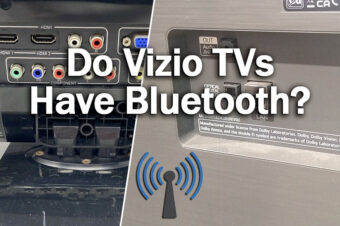


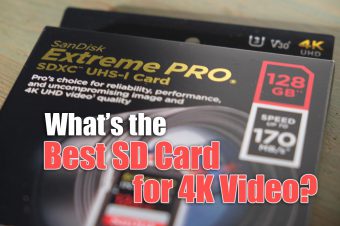
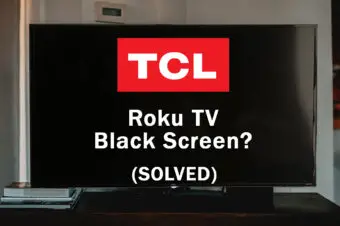
Leave a Reply